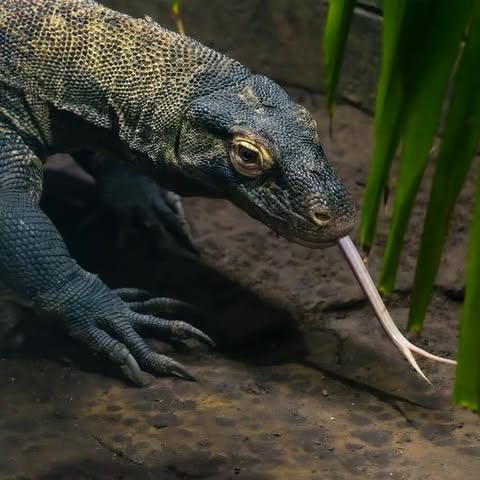- National Appreciate a Dragon Day and its significance in raising awareness about dragon species, including Komodo dragons.
- A detailed introduction to Naga, the Komodo dragon resident of Mesker Park Zoo & Botanic Garden.
- Biological and ecological characteristics of Komodo dragons, including their diet, habitat, and hunting methods.
- Current conservation status and threats faced by Komodo dragons, along with efforts to protect them.
- The role of zoos, such as Mesker Park Zoo & Botanic Garden, in wildlife conservation and public education.
National Appreciate a Dragon Day is a special occasion dedicated to celebrating one of the most intriguing reptiles on the planet: the dragon. While dragons have often been depicted in mythology and popular culture as mythical creatures, this day serves as an excellent opportunity to appreciate the real-life dragons that exist today. One such species is the Komodo dragon, a formidable predator native to Indonesia. This day fosters awareness about the ecological importance of these reptiles and encourages conservation efforts to protect endangered dragon species.
Nestled in the heart of Mesker Park Zoo & Botanic Garden is Komodo Cove, home to Naga, an impressive Komodo dragon. Naga, who weighs 46.5 pounds and stretches 75.5 inches long, is the queen of this habitat. As National Appreciate a Dragon Day approaches, Mesker Park Zoo celebrates not only this event but also Naga’s upcoming 12th birthday. Naga’s presence in the zoo provides a valuable opportunity for visitors to learn about Komodo dragons and their conservation needs.
Komodo dragons (Varanus komodoensis) are awe-inspiring creatures native to the Indonesian islands’ forests and savannahs. These large lizards, known for their deadly hunting abilities, have unique adaptations that allow them to thrive in their environment. Their powerful venom glands located in the lower jaw, paired with sharp, serrated teeth, make them effective predators. The venom contains anticoagulant properties that prevent blood clotting, aiding in subduing prey. Additionally, Komodo dragons are known to carry a variety of harmful bacteria in their saliva due to their diet of carrion, which contributes to their hunting efficiency.
Despite their fearsome reputation, much of a Komodo dragon’s diet consists of carrion, or decaying flesh. This dietary habit not only sustains them but also plays a critical role in their ecosystem. By consuming carrion, Komodo dragons help control the spread of disease and contribute to the natural nutrient cycle within their habitats.
Sadly, Komodo dragons face numerous threats in the wild. The most pressing threats include habitat loss due to residential and commercial development, climate change, and illegal hunting. The species has been classified as Endangered, with only 1,300 mature individuals estimated to remain in the wild, according to the International Union for Conservation of Nature’s (IUCN) 2019 assessment. These majestic reptiles are predominantly found on the west coast of the large island of Flores, located in the East Nusa Tenggara province of Indonesia.
Recognizing the importance of protecting this species, the Indonesian government established Komodo National Park in 1980. The park aims to conserve both the Komodo dragons and their natural habitat. Efforts to enforce anti-poaching laws and monitor their population are ongoing, reflecting the commitment to preserving these remarkable creatures.
Zoos play a crucial role in wildlife conservation and public education. At Mesker Park Zoo & Botanic Garden, Naga’s presence helps raise awareness about Komodo dragons and the conservation challenges they face. By providing an up-close experience, the zoo educates visitors about the importance of protecting these species and encourages support for conservation initiatives. Zoos worldwide collaborate to develop breeding programs and research projects that contribute to the species’ survival in the wild. Through these efforts, they serve as vital partners in global conservation strategies and inspire future generations to protect endangered species.
In conclusion, National Appreciate a Dragon Day serves as a reminder of the fascinating real-life dragons that inhabit our world. The story of Naga, residing at Mesker Park Zoo & Botanic Garden, highlights the significance of conservation efforts to safeguard these incredible creatures. By understanding Komodo dragons’ biological characteristics and ecological roles, we can work together to address the threats they face and ensure their survival for future generations. Through education and conservation partnerships, we can continue to appreciate and protect the natural world’s magnificent creatures, like the Komodo dragon.
*****
Source Description
Today is National Appreciate a Dragon Day, and Mesker Park Zoo & Botanic Garden has a dragon among it’s residents…👀
Weighing in at 46.5 pounds and 75.5 inches long, our Komodo Dragon Naga is the queen of Komodo Cove. Tomorrow is also her 12th birthday, Happy early birthday Naga!🥳
Komodo Dragons (Varanus Komodoensis) is a species native to the forests and savannahs of Indonesia. They were last assessed in August of 2019 as an Endangered species, with a stable population of only 1,300 mature individuals. These large lizards inhabit the west coast of the large island of Flores, which is in the East Nusa Tenggara province of Indonesia.
Komodo Dragons are famous for their lethal venom glads in the lower jaw. This venom, which prevents blood clotting, is paired another lethal component. The sharp, serrated shape of a Komodo dragon’s tooth holds bits of rotting flesh, turning their saliva into a culture of harmful bacteria. Despite these deadly hunting traits, a big part of a Komodo Dragon’s diet is carrion, or decaying flesh.
Threats to Naga’s species include residential and commercial development, climate change and severe weather, and hunting. In 1980, Komodo National Park was established to protect theis species and their unique habitat. Enforcing anti-poaching laws and population monitoring have also been introduced to protect this species.


